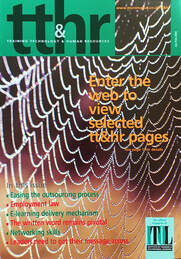Ten killer questions
Wright, N. (2004) ‘Ten Killer Questions’, Training Technology & Human Resources, Institute of Training & Occupational Learning, January-February, pp14-15.
Learning & Development (L&D) practitioners are increasingly called upon to provide internal consultancy (e.g. coaching and advice on change management) alongside conventional training services. Practitioners are, too, required to integrate individual learning with organisational learning in order to maximise benefits in both arenas. In light of this, I believe the ability to analyse, inform and enhance an organisation’s development strategy on the basis of individual and organisational learning is now a de facto critical competency for this profession.
The majority of L&D practitioners I encounter are, however, from professional teaching and training backgrounds where excellent skills have been acquired in such areas as creative course design, interpersonal communication and intra-group dynamics. In contrast, I meet relatively few L&D practitioners who are trained or experienced in learning, dynamics and development at wider organisational levels. Some broadening of core professional expertise may be required, therefore, to match the challenges of the future.
I work with L&D practitioners to expand insight in this latter arena using ‘reframing’, a technique that involves examination of tasks and situations from diverse new perspectives (see Gareth Morgan’s Images of Organisation, Sage, 1997). I’ve found that certain direct questions and provocative statements can help stimulate discussion and challenge presuppositions about L&D and its fit/role within a broader organisational context. After presenting each statement I will ask, “What do you think?” and discussion or debate inevitably ensues.
The approach is used in semi-structured consulting and group seminars and I’ve found 10 key perspectives to be particularly useful. The list is reproduced in table form below. The perspectives included are certainly not exhaustive and can be modified to suit specific practitioners and organisational situations (the notes in the ‘Perspective’ column are for explanatory purposes only).
Learning & Development (L&D) practitioners are increasingly called upon to provide internal consultancy (e.g. coaching and advice on change management) alongside conventional training services. Practitioners are, too, required to integrate individual learning with organisational learning in order to maximise benefits in both arenas. In light of this, I believe the ability to analyse, inform and enhance an organisation’s development strategy on the basis of individual and organisational learning is now a de facto critical competency for this profession.
The majority of L&D practitioners I encounter are, however, from professional teaching and training backgrounds where excellent skills have been acquired in such areas as creative course design, interpersonal communication and intra-group dynamics. In contrast, I meet relatively few L&D practitioners who are trained or experienced in learning, dynamics and development at wider organisational levels. Some broadening of core professional expertise may be required, therefore, to match the challenges of the future.
I work with L&D practitioners to expand insight in this latter arena using ‘reframing’, a technique that involves examination of tasks and situations from diverse new perspectives (see Gareth Morgan’s Images of Organisation, Sage, 1997). I’ve found that certain direct questions and provocative statements can help stimulate discussion and challenge presuppositions about L&D and its fit/role within a broader organisational context. After presenting each statement I will ask, “What do you think?” and discussion or debate inevitably ensues.
The approach is used in semi-structured consulting and group seminars and I’ve found 10 key perspectives to be particularly useful. The list is reproduced in table form below. The perspectives included are certainly not exhaustive and can be modified to suit specific practitioners and organisational situations (the notes in the ‘Perspective’ column are for explanatory purposes only).
|
|
I suggest that each perspective is tackled sequentially (although not slavishly, if natural conversation takes a different route) and using language that reflects the knowledge of the particular audience. At the end of each section I pose the question, ‘So what are the implications for your L&D practice?’ and ask the participant(s) to write down their reflections before moving on. I don’t try to tackle all questions in one session but move with the pace of individual practitioners in order to help maintain interest and avoid overload.
I’ve found this approach most effective when there is genuine opportunity for discussion and follow-up. After deconstruction of assumptions, for instance, it’s important to allow time for reconstruction of new, more holistic strategies; affirming existing knowledge and good practice as a foundation for the future. This helps build vision and confidence and prevents practitioners feeling disorientated or undermined. I also recommend allowing time towards the end of each session and at the start of each subsequent session for review of learning and, if needed, further enquiry.
Where possible, practitioners are encouraged to meet with peers between sessions and seminars to explore and resolve any emerging problems and concerns together. Where this is not possible (e.g. if a practitioner is working in an isolated role or remote location), I suggest that ideas are sounded out through an open discussion form such as UK HRD (www.ukhrd.com) and, if practitioners are members of a professional institute, via discussion groups on their respective websites (e.g. www.itol.co.uk; www.cipd.org.uk).
Andrew Mayo’s Creating a Learning & Development Strategy (CIPD, 2004) and Rosemary Harrison’s Learning & Development (CIPD, 2009) are particularly valuable books that help practitioners convert insight gained through this type of reflection process into renewed L&D practice. I do, therefore, recommend these texts to readers with further interest in this field. Other helpful points of reference for written ideas and information include the British Journal of Occupational Learning (www.itol.co.uk) and Organisations & People (www.amed.org.uk).
If any of the perspectives in this short article have triggered new ideas in your own thinking, why not jot them down and ask a colleague to give you feedback? My own experience suggests that double-loop learning on one’s own perspectives and practice can be a challenging and stimulating starting point!
